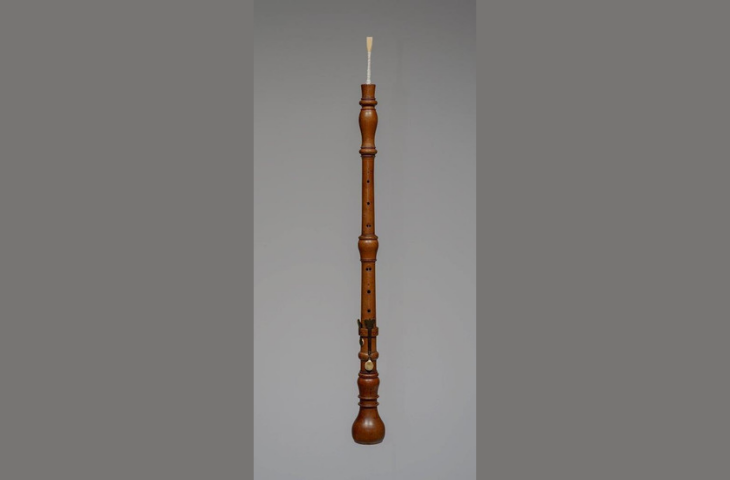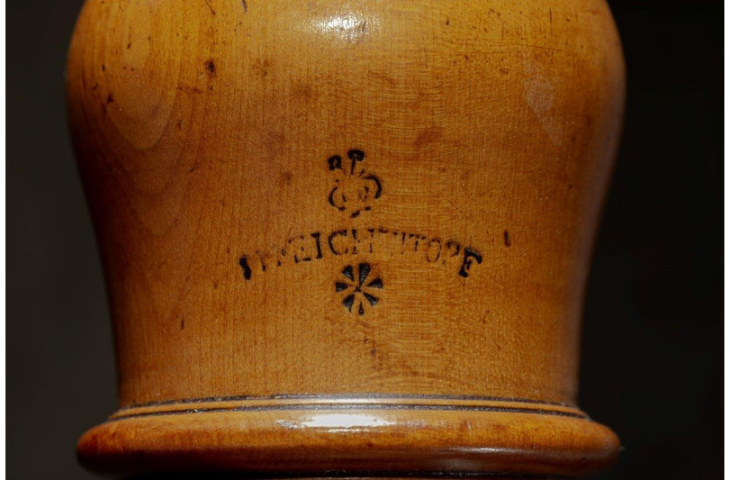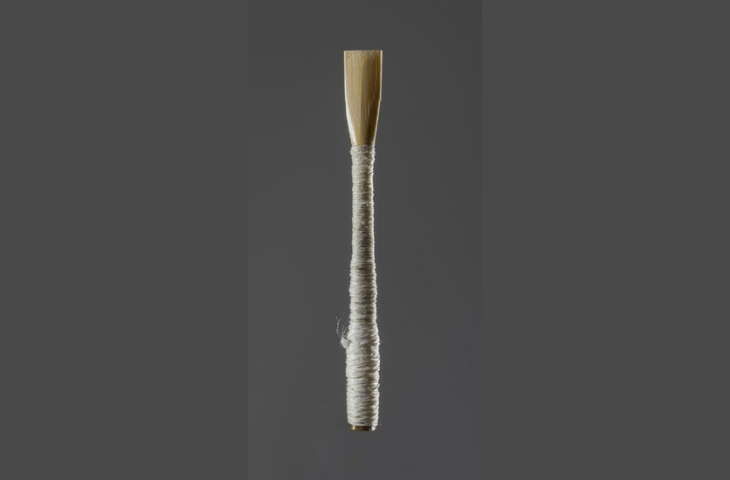November 2023
Fig.1

Oboe d'amore, Johann Heinrich Eichentopf, Leipzig, around 1730, inv. 0971
Fig.2

Oboe d'amore (detail brand), Johann Heinrich Eichentopf, Leipzig, around 1730, inv. 0971
Fig.3

Oboe double reed, Marcel Ponseele, Brussels, 2022, inv. 2022.0167.001
Fig.4

Oboe double reed (detail opening) Marcel Ponseele, Brussels, 2022, inv. 2022.0167.001
An incomplete instrument since 1883
An oboe d’amore - or hautbois d’amour - from MIM’s collections had long lost its double reed. The reed, essential for producing sound, had in fact disappeared shortly after the instrument was acquired in 1883. Unfortunately, it is not unusual for wind instruments to be missing a reed or a mouthpiece. These small, detachable and fragile components have often been replaced several times by the musicians themselves and may have become separated from their instrument over the course of its history.
To give the public a correct reading of an object on display, it is preferable to show it with all its attributes. But this is not always possible, for example because of the state of conservation of a given instrument or a lack of reliable knowledge, and an object may then be presented “as is”. In this case, it was decided to give a new double reed to Johann Heinrich Eichentopf’s oboe d’amore, dating from the second quarter of the 18th century. It was made as it would have been at the time, using reed, brass, linen thread and beeswax. Marcel Ponseele and Stefaan Verdegem, two musicians who specialise in historical oboes, joined forces at the museum to produce this historical reed. Marcel also makes oboes with his brother Francis. Stefaan, in addition to his teaching and concert activities, has produced a catalogue raisonné of the oboes in the MIM (http://brusselsmimoboecollection.kcb.be).
Making a historical double reed
Making an oboe double reed requires the right materials, the right tools and, above all, know-how and a little patience. While oboists - even those playing on modern oboes - usually make their own reeds, crafting a historical reed, without the help of machines, is truly a craft. The main stages, which can be seen in the film made in the MIM’s restoration workshop, are summarised here.
The first step is to make the staple (or bocal), a conical metal tube that will hold the reed itself and be inserted into the instrument. It is made from a 0.4 mm thick sheet of brass, wound around a small mandrel. Then, using a piece of reed (Arundo donax) 15 mm in diameter, the reed is cut, gouged and scraped to give it its general shape. It is moistened to make it easier to work without breaking.
A linen thread is wrapped around the staple, and the reed is fixed to it using another thread coated in beeswax. The reed is then scraped and cut to the right length to allow its edges to vibrate freely against each other, following the principle of the double reed. This principle applies to all types of oboe, both classical and traditional, as well as to bassoons and various bagpipes. A trial run on the instrument allows the makers to check that the work has been done properly. The double reed is then placed in the display case alongside the instrument it was made for.
A soft, forgotten voice revived
The oboe d’amore is longer than the standard oboe and is tuned a third lower, in A. It has a conical bore and, as we have seen, a double reed. It is most often recognised by its distinctive bulb- or pear-shaped bell, known as the Liebesfuss or pavillon d’amour (literally: love bell), although it may also have a normally flared bell. Its tone is softer than that of the oboe – both warm and melancholic – and is therefore associated with the words amore, amour, and Liebe.
In the first half of the 18th century, the instrument was very popular in German-speaking countries. Johann Sebastian Bach wrote several beautiful works and passages for it, as did other composers such as Christoph Graupner and Georg Philipp Telemann. As musical tastes changed – or maybe because love only lasts so long – the oboe d’amore fell out of fashion in the 1740s and had practically disappeared by the end of the century. It was not until the end of the Romantic era and the rediscovery of Bach’s music that the instrument re-emerged. It was subsequently modernised, fitted with additional keys, and regularly integrated into symphony orchestras. The man who would become the first curator of the MIM, Victor-Charles Mahillon (1841–1924), played a key role in the instrument’s revival. He therefore purchased this example with full knowledge of its value, in 1883.
We hope you enjoy (re)discovering the instrument and its new reed in the display case on the +1 floor of the museum, as well as the making-of film below.
Text: Géry Dumoulin
Bibliography
- S. Verdegem, “Fétis, Gevaert, Mahillon and the Oboe d’Amore”, The Galpin Society Journal, vol. 68 (March 2015), pp. 75-120.
- G. Burgess, The Oboe, New Haven, London, Yale University Press, 2004.
- B. Haynes, The Eloquent Oboe: A History of the Hautboy from 1640 to 1760, Oxford, Oxford University Press, 2001.
- A History of the Hautboy from 1640 to 1760, Oxford, Oxford University Press, 2001.